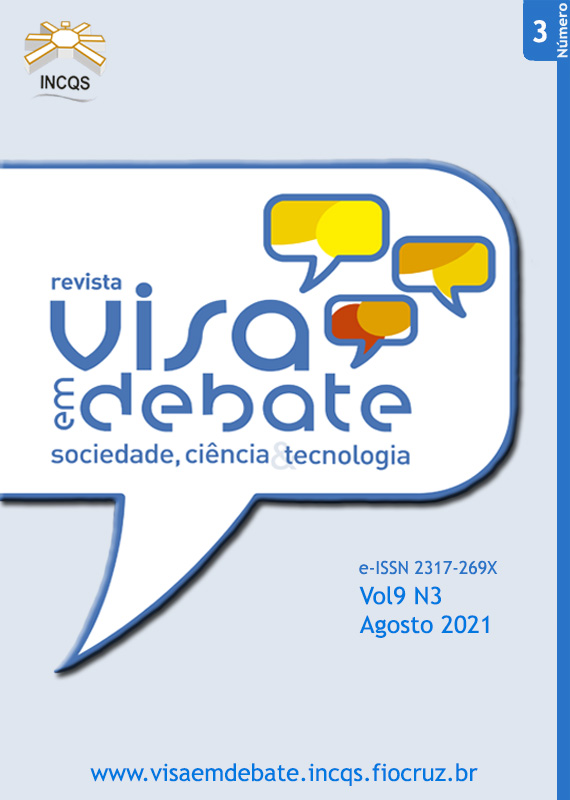Post-market monitoring of rapid diagnostic tests for COVID-19: confronting the pandemic
DOI:
https://doi.org/10.22239/2317-269X.01781Keywords:
COVID-19; SARS-CoV-2; Rapid Diagnostic Test; Quality MonitoringAbstract
Introduction: In December 2019, the first group of patients with symptoms of atypical pneumonia was discovered in Wuhan, China. On January 7, 2020, the etiologic agent was identified; it was a new betacoronavirus, genetically similar to SARS-CoV-1, consisting of a simple RNA strand, an enveloped virus of 50-200nm in diameter, which was called SARS-CoV-2. Soon after, the disease was named COVID-19. On January 30, WHO declared a Public Health Emergency of International Importance due to the spread of the coronavirus. Tests for serological detection of IgM and IgG antibodies are those that provide an estimate of the immune response to SARS-CoV-2, highlighting the Rapid Diagnostic Tests (RDT), simple and accessible with a result within 5-30 minutes, based on sensitization of antigens/antibodies conjugated to colloidal gold capturing specific proteins present in the infected serum, plasma or blood. Objective: This work aims to show the analysis carried out with RDT for COVID-19 diagnosis in compliance with the current legislation from 02.04 to 18.08.2020. Method: In March of 2020, 25 serum/plasma samples were donated, without any identification. These samples were the remaining samples of tests performed on individuals with a confirmed diagnosis of SARS-CoV-2 infection by the RT-PCR technique from health services (National Institute of Infectious Diseases Evandro Chagas – INI and State Institute of the Brain Paulo Niemeyer – IEC) located in the metropolitan region of the state of Rio de Janeiro. The samples obtained in order to become a serological panel were stored at -20ºC until the moment of use. Simultaneously, a panel of samples with confirmed reactivity for IgM and IgG antibodies from COVID-19 was being made, throughout the pandemic and the samples used were evaluated against three Rapid Tests, of different antigenic compositions or different brands; two ELISA tests for IgM and IgG; two chemiluminescence tests and when applicable, a molecular test. In order to assess the specificity of the products sent, surplus donation plasma samples were selected, known to be negative for HIV, HTLV, hepatitis b and c, chagas and syphilis, collected between 2013 and 2014, in the southern regions of the country, period in which SARS-CoV-2 was nonexistent in the world. In addition to True Positive (VP) and True Negative (VN) samples, interfering serum or plasma samples with reactivity for HIV, HCV, HTLV, HBsAg, chagas disease, syphilis and dengue were also included in the evaluation. Results: Out of 178 TR lots, 74.1%, 132 lots were from China and 25.9%, 46 TR lots were from Brazil; Germany; South Korea; Canada; USA; Singapore; Ireland and Switzerland. The analytical result showed that 57.0%, 101 TR lots obtained a Satisfactory result and 43%, 77 lots had Unsatisfactory results, when compared to the Sensitivity and Specificity values declared by the manufacturer, in the Instructions for Use. Conclusions:The results obtained show the need for constant monitoring of TRs for COVID-19 with the primary purpose of guaranteeing the quality of products sold in the country, one of the National Health Surveillance System pillars of action.
Downloads
Downloads
Published
Issue
Section
License
Copyright (c) 2021 Health Surveillance under Debate: Society, Science & Technology (Vigilância Sanitária em Debate: Sociedade, Ciência & Tecnología) – “Visa em Debate”

This work is licensed under a Creative Commons Attribution-NonCommercial 4.0 International License.
COPYRIGHT ALLOWANCE The author (s) hereinafter designated as the ASSIGNOR hereby assign and transfer, free of charge, the ownership of the copyrights related to this ARTICLE to the Vigilância Sanitária em Debate: Sociedade, Ciência & Tecnologia (Health Surveillance under Debate: Society, Science & Technology) – Visa em Debate, represented by FUNDAÇÃO OSWALDO CRUZ, established at Av. Brasil, nº 4365, Manguinhos, Rio de Janeiro, RJ, Brazil, CEP 21045-900, under the conditions set out below: (a) The terms and conditions set forth in this Agreement shall apply to the following: 1. The ASSIGNOR declares that they s(he) is (are) the author (s) and owner (s) of the copyrighted property of the ARTICLE submitted. 2. The ASSIGNOR declares that the ARTICLE does not infringe the copyrights and / or other property rights of third parties, that the disclosure of images (if any) has been authorized and that they s(he) assume(s) full moral and / or property liability for its content, before third parties. 3. THE ASSIGNOR assigns and transfers all copyrights relating to the ARTICLE to the ASSIGNEE, especially the rights of editing, publication, translation into another language and reproduction by any process or technique. The ASSIGNEE becomes the exclusive owner of the rights related to the ARTICLE, and any reproduction, totally or partially, is prohibited in any other means of publicity, printed or electronic, without prior written authorization from the ASSIGNEE. 4. The assignment is free and, therefore, there will be no remuneration for the use of the ARTICLE by the ASSIGNEE.






